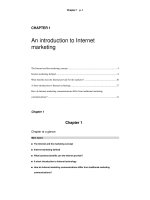Welcome to hospitality an introduction
Bạn đang xem bản rút gọn của tài liệu. Xem và tải ngay bản đầy đủ của tài liệu tại đây (12.19 MB, 513 trang )
Welcome to Hospitality
…an Introduction
3rd EditionWelcome to Hospitality
an Introduction
3rd Edition
KAYE (KYE-SUNG) CHON, PH.D., CHE
Chair, Professor, and Director
School of Hotel and Tourism Management
The Hong Kong Polytechnic University
THOMAS A. MAIER, PH.D
President, TAM-Global Services Inc.
International Professor of Service Leadership and Innovation
Rochester Institute of Technology in Dubai
Austr alia • Brazil • Japan • Korea • Mexico • Singapore • Spain • United Kingdom • United States
Welcome to Hospitality . . . an
Introduction, 3rd Edition
Kaye (Kye-Sung) Chon and Thomas A.
Maier
Vice President, Career and Professional
Editorial: Dave Garza
Director of Learning Solutions: Sandy Clark
Acquisitions Editor: James Gish
Managing Editor: Larry Main
Product Manager: Anne Orgren
Editorial Assistant: Sarah Timm
Vice President, Career and Professional
Marketing: Jennifer McAvey
Marketing Director: Wendy Mapstone
Marketing Manager: Kristin McNary
Marketing Coordinator: Scott Chrysler
Production Director: Wendy Troeger
Senior Content Project Manager: Nina
Tucciarelli
Art Director: Bethany Casey
© 2010, 2000, 1995 Delmar, Cengage Learning
ALL RIGHTS RESERVED. No part of this work covered by the copyright
herein may be reproduced, transmitted, stored or used in any form
or by any means graphic, electronic, or mechanical, including but not
limited to photocopying, recording, scanning, digitizing, taping, Web
distribution, information networks, or information storage and retrieval
systems, except as permitted under Section 107 or 108 of the 1976
United States Copyright Act, without the prior written permission of
the publisher.
For product information and technology assistance, contact us at
Cengage Learning Customer & Sales Support, 1-800-354-9706
For permission to use material from this text or product,
submit all requests online at www.cengage.com/permissions.
Further permissions questions can be e-mailed to
Library of Congress Control Number: 2009920753
ISBN-13: 978-1-4283-2148-9
ISBN-10: 1-4283-2148-9
Delmar
5 Maxwell Drive
Clifton Park, NY 12065-2919
USA
Cengage Learning is a leading provider of customized learning
solutions with office locations around the globe, including Singapore,
the United Kingdom, Australia, Mexico, Brazil, and Japan. Locate your
local office at: international.cengage.com/region
Cengage Learning products are represented in Canada by Nelson
Education, Ltd.
To learn more about Delmar, visit www.cengage.com/delmar
Purchase any of our products at your local college store or at our
preferred online store www.ichapters.com
Notice to the Reader
Publisher does not warrant or guarantee any of the products described herein or perform any
independent analysis in connection with any of the product information contained herein. Publisher
does not assume, and expressly disclaims, any obligation to obtain and include information other
than that provided to it by the manufacturer. The reader is expressly warned to consider and adopt
all safety precautions that might be indicated by the activities described herein and to avoid all
potential hazards. By following the instructions contained herein, the reader willingly assumes all
risks in connection with such instructions. The publisher makes no representations or warranties of
any kind, including but not limited to, the warranties of fitness for particular purpose or
merchantability, nor are any such representations implied with respect to the material set forth
herein, and the publisher takes no responsibility with respect to such material. The publisher shall
not be liable for any special, consequential, or exemplary damages resulting, in whole or part, from
the readers’ use of, or reliance upon, this material.
Printed in Canada
123456715141312111009
This page intentionally left blank
Preface xiii
PART1 THESPIRITOFHOSPITALITY 3
Ch 1: Welcome to the Hospitality Industry . . . 5
The Scope of the Hospitality Industry . . . 6
Business Profile: Post Hotel and Spa 11
Professional Profile: Ian Schrager 13
Service—The Mission and Product of Hospitality 14
Business Profile: Starbucks . 15
A Day in the Life of . . . A Front Desk Clerk 24
Pursuing Opportunities in Hospitality . . 25
Professional Profile: Michael Murphy . . . 27
End-of-Chapter Exercises . . 37
Ch 2: Travel and Tourism: Partners in Hospitality 39
The Relationship of Hospitality to Travel and Tourism . 40
Business Profile: Alaska Airlines 44
A Day in the Life of . . . A Travel Agency Manager 48
Professional Profile: Thomas Cook 50
Marketing and Promoting Tourism and Travel 55
Business Profile: The Cove Atlantis Resort Hotel 56
Business Profile: Disney Theme Parks . . . 63
The Effects of Hospitality, Tourism and Travel 64
Graduate Glimpse: Nandita Sharma 65
End-of-Chapter Exercises . . 75
vii
PART2 LODGING 79
Ch 3: Dynamics of the Lodging Industry 81
The Evolution of Lodging Facilities . 82
Classifying Lodging Properties 85
Professional Profile: Barry Sternlicht 88
A Day in the Life of … A Concierge 95
Types of Lodging Ownership 97
Marketing 103
Business Profile: Hyatt Hotels and Resorts 107
Graduate Glimpse: Ryan Eddy 108
End of Chapter Exercises 113
Ch 4: Hotel Development . 115
An Overview of the Process 116
Choosing the Right Location 118
Business Profile: Four Seasons Hotel 119
Business Profile: Las Vegas (Nevada) City Center . 121
Professional Profile: Steve Wynn . . . 122
Assessing Feasibility . 125
Fiscal Commitment to the New Hotel 129
A Day in the Life of … A Market Analyst 130
Design of the New Hotel 137
End of Chapter Exercises 145
Ch 5: Hotel Management and Operations 149
Basic Management Structure 150
Graduate Glimpse: Jeremy Ashby . . 154
A Day in the Life of . . . The Chief Engineer 162
Human Resources Management Issues 165
Business Profile: Red Roof Inns . . . 167
Producing an Efficient and Profitable Operation . . 176
Referrals and Ratings Systems 179
End-of-Chapter Exercises 184
PART3 FOODSERVICE 187
Ch 6: Hospitality and the Foodservice Industry 189
The Relationship of Market, Concept, and Menu . . 190
Contemporary Commercial Foodservice Concepts . 202
Business Profile: Roy’s Restaurants . 202
Restaurant Ownership 212
Professional Profile: Guy and Franck Savoy 213
Business Profile: Howard Johnson’s 216
Commercial Restaurants Within Other Businesses 217
Business Profile: Kimpton Hotels . . 218
viii Contents
Contemporary On-Site (Institutional) Foodservice 221
Graduate Glimpse: Michele Polci 227
End-of-Chapter Exercises . . 230
Ch 7: Introduction to Culinary Arts 233
Historical Overview of Cookng and the Culinary Arts . . 234
Elements of American and European Fine Dining 236
Professional Profile: Auguste Escoffier . . . 238
Graduate Glimpse: Chef Profile: Mark Baker 240
A Day in the Life of . . . A Chef 242
Menu Planning and Development 245
The Production Cycle 251
Social Issues . 257
End-of-Chapter Exercises . . 265
Ch 8: Beverage Management 269
Trends in Beverage Consumption 270
Wines 276
Business Profile: “Pure”—Las Vegas Caesar’s Palace Hotel 276
Professional Profile: Dom Perignon 282
Business Profile: Rothschild’s Winery . . . 286
A Day in the Life of . . . A Sommelier 291
Liquors 292
Malt Beverages 297
Risk Management and Liquor Liability . . 300
End-of-Chapter Exercises . . 304
PART 4 SPECIALIZED SEGMENTS OF THE
HOSPITALITYINDUSTRY 307
Ch 9: Meetings, Conventions, and Special Events 309
Meetings, Conventions, and Expositions . 310
Opportunities in the Meetings Industry . . 323
A Day in the Life of . . . A Meeting Planner 325
Business Profile: Loews Anatole Hotel . . . 328
Sports Management Career Opportunities 329
Professional Profile: J. Williard “Bill” Marriott 332
End-of-Chapter Exercises . . 334
Ch 10: Recreation and Leisure 337
Managing Leisure Segments of the Hospitality Industry 338
Novel Lodging Facilities . . . 341
Clubs 343
Health and Wellness Facilities 347
Recreational Facilities 349
Contents ix
Graduate Glimpse: Joe Vandel Heuvels 355
Business Profile: Grand Teton Lodge Company . . . 356
Professional Profile: Samuel Cunard 359
End-of-Chapter Exercises 363
Ch 11: Global Gaming and Casino Operations 365
History of Gambling and Current Status 366
Business Profile: Weathering the Storms: Harrah’s New Orleans 374
Major Players in America 375
The Pros and Cons of Gambling . . . 377
Similarities and Difference Between Casinos and Other
Hospitality Operations 379
Security and Surveillance 382
Power Structures . . . 382
Budgets and Finance . 383
Casino Customers . . . 383
Casino/Resort Organizational Structure 385
A Day in the Life of . . . A Casino Manager 387
Mechanicals or Slots . 393
Slot Service Personnel 394
End of Chapter Exercises 397
PART5 THEFUTUREANDYOU 401
Ch 12: Globalization and the Future of Hospitality 403
Economic Climate . . . 404
Demographics and Socioeconomic Trends 405
Technological Innovations 407
Professional Profile: Ellsworth Statler 408
Government Regulation and the Hospitality Industry 411
Unions 412
Focus on the Future . 413
Trends . 428
Ethics in Hospitality . 434
End-of-Chapter Exercises 436
Ch 13: Building for Success 439
Some Basic Business Skills 440
Steps to a Career in Hospitality . . . 445
Professional Profile: Adrian Zecha . . 448
Getting the Job 453
A Day in the Life of . . . A Human Resources Director 457
End-of-Chapter Exercises 461
x Contents
APPENDICES
Appendix A Commonly Used Acronyms 465
Appendix B Hospitality Industry Associations and Organizations 469
Glossary . . . 473
Index 483
Contents xi
This page intentionally left blank
Preface
Welcome to Hospitality: An Introduction, 3rd Edition explores the fascinating
worlds of lodging, foodservice, meeting planning, travel and tourism, gaming,
sports management, revenue management principles, and the related busi-
nesses that make up the hospitality industry. This edition identifies the latest
trends found throughout the industry and addresses what the industry is do-
ing to adapt to modern technology.
Perhaps you are considering a career in hospitality. If so, this book will help
you decide. Alternatively, you may have already decided to pursue a career in
hospitality but want to broaden your understanding of the industry. If so, this
book will help you understand how all parts of the industry are related.
Welcome to Hospitality is designed to:
• Arouse your interest in the many career opportunities available in the
industry.
• Help prepare you for the challenges faced by professionals in hospitality
management.
• Explore trends that will have an impact on your future in the industry.
• Provide a global perspective on present and future industry issues.
• Suggest directions for educational and professional development.
• Share the enthusiasm and excitement that are part of the hospitality spirit.
Background
While hospitality is an “industry,” its roots lie in social and cultural life.
Throughout history, the industry has been shaped by the societies and cultures
in which it has grown. Societal and cultural issues continue to shape the
industry—issues like environmental concerns, economic changes, the increase
in women business travelers, and legislation affecting smoking in restaurants.
Today, leadership in the hospitality industry goes far beyond traditional
skills in operations. Leaders must be able to understand and predict how hos-
pitality will be affected by the changing world. Welcome to Hospitality describes
xiii
the industry in relation to social trends and cultural patterns. It will help you
develop the leadership skills that are so important in this dynamic industry.
Perhaps the most striking contemporary trend affecting the hospitality in-
dustry is “globalization.” Nations no longer exist in quiet independence but
in growing interdependence. As a result, Western countries and cultures have
begun to recognize the strength, vitality, and complexity of other nations and
cultures. The third edition of Welcome to Hospitality has been revised with a
deep appreciation of other traditions and cultures. But it is not an “inter-
national” book in the sense that all cultural and historical forms of hospitality
are represented. The authors acknowledge that their own cultural heritages
and industry experiences are limited.
Through history, the spirit of hospitality embodied the obligations to treat
strangers with dignity, to feed them and provide them with drink, and to pro-
tect their safety. As the world becomes increasingly smaller and more aware of
its vast diversity, this “spirit of hospitality” seems especially important. Wel-
come to Hospitality invites you to share in this spirit.
Supplements
Instructor’s Manual
An Instructor ’s Manual is available to accompany this text. Included in the
Instructor’s Manual are correlations of chapter objectives and end-of-chapter
exercises and activities to the SCANS (Secretary’s Commission on Achieving
Necessary Skills) competencies. The Instructor’s Manual also contains chapter
outlines, answers or suggested solutions to all end-of-chapter exercises, chap-
ter tests and answers, and transparency masters.
Instructor Resources CD
New to this edition, an Instructor Resources CD is available to accompany this
text. In addition to the Instructor’s Manual contents, the Instructor Resources
CD contains an ExamView
®
computerized test bank and PowerPoint© lecture
slides to accompany each chapter.
Organization and Content
Welcome to Hospitality…An Introduction, 3rd Edition is organized into five parts
and thirteen chapters.
Part 1, The Spirit of Hospitality, includes two introductory chapters.
• Chapter 1, Welcome to the Hospitality Industry, defines hospitality
from the perspective of the guest. It introduces the various segments of
the industry as well as important themes that are presented throughout
the text.
• Chapter 2, Travel and Tourism: Partners with Hospitality, helps you un-
derstand the relationship between travel and tourism on one hand and
lodging and related hospitality businesses on the other.
xiv Preface
Part 2, Lodging, explores the lodging industry, past and present.
• Chapter 3, Dynamics of the Lodging Industry, explores the evolution of
the lodging industry and classifications of various lodging properties and
prototypes.
• Chapter 4, Hotel Development, introduces you to hotel development,
including the planning, forecasting, design, construction, and opening
processes.
• Chapter 5, Hotel Management and Operations, provides an overview of
the management and operation of a hotel. Management structure, human
resources, and the function of each department are discussed.
Part 3, Foodservice, covers the foodservice industry.
• Chapter 6, Hospitality and the Foodservice Industry, presents the variety
of commercial and on-site foodservice types. You win learn to analyze a
foodservice operation in terms of its market, concept, and menu.
• Chapter 7, Introduction to Culinary Arts, outlines the traditions of culi-
nary arts, the organization of the kitchen, and the production cycle.
• Chapter 8, Beverage Management, introduces you to the variety of bev-
erages that have traditionally been part of foodservice. You will learn
about winemaking, brewing, and distilling. This chapter also emphasizes
the responsibility hospitality operations have toward guests concerning
alcohol consumption.
Part 4, Specialized Segments of the Hospitality Industry, introduces
industry segments that cater to business travelers and long-term guests
and that manage leisure and recreation activities for guests. Although these
segments are not necessarily related to each other, foodservice and lodging
play a vital role in their operations.
• Chapter 9, Meetings, Conventions, and Special Events, introduces you to
the rapidly growing meeting, convention, exposition, sports management,
and long-term health-care industries.
• Chapter 10, Recreation and Leisure Industry, presents recreation manage-
ment and theme parks, resorts, and related segments of the hospitality
industry.
• Chapter 11, Global Gaming and Casino Operations, presents the major
players in the industry and the pros and cons of gambling. The casino
customer is profiled, along with career opportunities in the fast-growing
gaming industry.
Part 5, The Future and You, looks at the impact of the twenty-first century
on hospitality and tourism.
• Chapter 12, Globalization and the Future of Hospitality, explores the
future of the hospitality industry in terms of demographic, global, and
technological trends.
Preface xv
• Chapter 13, Building for Success, looks to your future in the hospitality
industry and suggests ways that you can plan for success.
New to This Edition
The third edition of Welcome to Hospitality: An Introduction has been updated
by unique industry perspectives and professional profiles, comprehensive ca-
reer opportunities in the hospitality and tourism network, practical industry
applications, new-graduate glimpses, new references, and an extensive chapter
on gaming. A truly exhaustive revision, the third edition features the follow-
ing chapter-by-chapter enhancements:
Chapter 1: Welcome to the Hospitality Industry
This chapter has added new introductory sections on special events manage-
ment, sports management, and gaming with updated business profiles reflect-
ing current trends within the hospitality and tourism network.
Chapter 2: Travel and Tourism: Partners with Hospitality
Includes updated statistical data related to international tourism expenditures
and world tourism growth overall.
Chapter 3: Dynamics of the Lodging Industry
Has expanded coverage of the growing lodging sector, featuring hotel product
types that are new to the industry. Also presents the world’s largest lodging/
management companies, with insight into the idiosyncrasies of third-party
managerial contracts.
Chapter 4: Hotel Development
Offers extensive coverage of specific hotel development criteria and building
econometrics. Presents and discusses financial pro forma feasibility studies
that include cost estimates of new hotel prototype development. Provides a
breakdown of the top hotel brands among management companies.
Chapter 5: Hotel Management and Operations
This chapter has been substantially expanded and updated because of grow-
ing interest in operations management and financial performance. We have
added new material on revenue management and its importance in yielding
higher profit margins. Also discussed is the latest in organizational structure,
reflecting current salary ranges found in the lodging sector.
Chapter 6: Hospitality and the Foodservice industry
Includes new material on the top ten independent restaurants in the United
States, as well as statistical data on sales volumes, average checks, and meals
served. There is also new information on consumer choice top selected chain
restaurant winners, and industry perspectives on franchise strategy and cost-
benefit analysis of independent versus owned restaurants.
xvi Preface
Chapter 7: Introduction to Culinary Arts
Offers updated information and material on culinary certification programs,
including master chef, executive chef, and pastry chef positions.
Chapter 8: Beverage Management
New discussions have been included on the trends and new products in the
beverage industry. Top beverage brands are highlighted by market share and
new information is included on emerging international wine regions.
Chapter 9: Meetings, Conventions, and Special Events
This chapter provides a new section identifying the growing trends in
event planning and management. Career opportunities are identified in the
club and sports management fields, with specific careers in event planning
presented. Updated figures and tables help to break down revenues and
expenditures associated with the convention, exhibition, and meetings
industry.
Chapter 10: Recreation and Leisure Industry
Presents new coverage of market profiles and career opportunities associated
with the burgeoning cruise ship industry, There are also new statistics on the
top ten luxury resorts in the world, plus an expanded section on sustainable
tourism.
Chapter 11: Global Gaming and Casino Operations
This chapter examines the legalization of casinos and the history of gambling
worldwide. The chapter shows how American casinos are different from other
global ventures and who the major casino companies are today. It discusses
the pros and cons of allowing casinos to open, as the establishment of new
gaming jurisdictions slows down in America following a series of industry
mergers. The chapter closes by discussing the details of gaming operations
and the career opportunities they offer.
Chapter 12: Globalization and the Future of Hospitality
Presents updated statistical information on the world’s fifty largest hotel
chains, consumer satisfaction indexes, and trends in changing hospitality
workforce demographics. Included is in-depth coverage and discussion of the
future of technology and its importance to online travel planning, revenue
management systems, and video conference capabilities.
Chapter 13: Building for Success
This chapter has been updated to reflect current statistical data on the pro-
jected growth of food service and lodging industry managerial occupations,
as well as current reference sources for travel industry and hospitality related
jobs.
Preface xvii
Learning Tools
The revised edition of Welcome to Hospitality provides a number of tools to
help you learn.
Overview and Objectives
Each chapter begins with an overview that outlines what you should learn.
The objectives that follow help you focus on the main points and see the se-
quence of information that will be covered.
Key Terms
As you work through this book, you will notice that we have set important
industry terms in boldface and have defined them in context when introduced.
Also, we have spelled out acronyms the first time they appear in the text. All
key terms are listed in the Glossary, and Appendix A provides an alphabetical
listing of the most commonly used acronyms for terms and organizations in
the industry.
Feature Pages
Throughout the chapters, you will find a variety of interesting feature articles.
• Professional Profiles present the lives, achievements, and contributions to
the industry of individuals such as Barry Sternlicht, Thomas Cook, and
J. Willard Marriott.
• A Day in the Life of. . . features give an inside look at various careers in the
industry. They provide background information on job responsibilities,
daily tasks, and attributes needed to be successful on the job.
• Business Profiles provide an historical perspective on leading companies
including Disney Theme Parks, Hyatt Hotels and Resorts, and Roy’s
Restaurants.
• Graduate Glimpses convey current information and peer advice from suc-
cessful hospitality graduates.
• Industry Insights provide interesting facts and trivia on history, law and
ethics, culture, technology, business innovations, and the environment.
Chapter Summary
Each chapter ends with a summary of the topics and issues covered in the
chapter to help reinforce its learning objectives and prepare you for the exer-
cises and critical thinking activities that follow.
End-of-Chapter Exercises
Check Your Knowledge questions test your recall on topics discussed throughout
the chapter. Apply Your Skills activities focus your knowledge on industry pro-
blems. What Do You Think? questions challenge your critical thinking skills on
issues relevant to the material in each chapter. Case Studies provide scenarios
for further discussion and activities. The Internet Exercises, new to this edition,
encourage investigation of a variety of topics on the World Wide Web.
xviii Preface
Biographical Information
Kaye (Kye-Sung) Chon, Ph.D., is a former Professor and Director of the Tourism
Industry Institute at Conrad N. Hilton College at the University of Houston in
Houston, Texas. Currently, Dr. Chon is the Chair Professor and Director of
Hotel and Tourism Management at the Hong Kong Polytechnic University.
He has published over two hundred articles on hospitality industry issues.
Dr. Chon is the executive editor of the Journal of Hospitality and Tourism Research
as well as editor-in-chief of the Journal of Travel and Tourism Marketing and the
Asia Pacific Journal of Tourism Research. In 1993, Dr. Chon received the presti-
gious John Wiley & Sons Award from the Council on Hotel, Restaurant, and
Institutional Education for his lifetime achievement in scholarship and research.
Thomas A. Maier, Ph.D., is an International Professor of Service Leadership
and Innovation at the Rochester Institute of Technology in Dubai. He is also
the president of TAM—Global Services Inc. He has acquired a wide range of
hospitality, development, and practical business experience over the past
twenty-five years working for the Starwood and Red Lion Hotel brands.
Most recently, he served as vice president of hotel operations for the Red
Lion Hotel Corporation from 2001 until 2008, having held various manage-
ment positions within that corporation since 1992. Dr. Maier was recently
named the recipient of the RIT—2008 Dr. Paul Kazmierski Memorial Award
from the School of Hospitality and Service Management for his achievements
in and commitment to the field of human resource development.
Kathryn Hashimoto, Ph.D., author of the Global Gaming and Casino Opera-
tions chapter, is associate professor in the Department of Hospitality Manage-
ment at East Carolina University. She received a PhD in Marketing from
Century University, and a PhD in Curriculum and Instruction from the Uni-
versity of New Orleans. Her research interests are international consumer be-
havior, advertising, service management, and gaming. She is a renowned
author and researcher and her articles have appeared in gaming and hospital-
ity industry publications.
Reviewers
JOHN N. MELLON
Misericordia University
Dallas, PA
RICHARD J. MILLS, JR.
Robert Morris University
Moon Township, PA
KEN MYERS
University of Minnesota, Crookston
Crookston, MN
DENIS P. RUDD
Robert Morris University
Moon Township, PA
JAN VAN HARSSEL
Niagara University
Niagara, NY
Photography Credits for Part Opener Images:
Part Openers I, II, III: I mage copyright © Jim Smith Photography.
Part Opener IV: Image copyright Gary Paul Lewis, 2009. Used under license from Shutterstock.com
Part Opener V: Image copyright James Steidl, 2009. Used under license from Shutterstock.com
Preface xix
Hospitality
A universal symbol for hospitality is the pineapple. While
the exact origin of this symbol is unknown, many believe
the idea was borrowed from the people—most likely in-
habitants of Brazil—who first domesticated the pineap-
ple.
1
These people placed pineapples outside their
homes to signify that visitors were welcome. European
explorers introduced the fruit to Europe and the Ameri-
can colonies in the seventeenth century. As the exotic
fruit was rarer and more costly than caviar, it symbolized
the very best in hospitality. It was used to welcome and
honor royal and wealthy guests.
The idea of hospitality, of course, dates back much
further—from historical evidence found at the first cen-
ters of civilization (such as Mesopotamia in present-day
Iraq), to Biblical references of the washing of guests’ feet,
to later accounts of English innkeepers receiving weary
travelers over a mug of ale. The core concept of hospital-
ity, however, has remained the same: to satisfy and
serve guests.
In this text you are offered the proverbial pineapple as
you embark on a journey to explore the world of manag-
ing guest service. Welcome to the hospitality industry!
ch1 Welcome to the
Hospitality
Industry
ch2 Travel and
Tourism: Partners
with Hospitality
PART 1
This page intentionally left blank
ch1
Welcome to the
Hospitality Industry
OVERVIEW
What is hospitality? Ask this of fifty people and you are
likely to receive fifty different answers. “Receiving
guests in a generous and cordial manner.”“Creating a
pleasant or sustaining environment.”“Satisfying a
guest’s needs.”“Anticipating a guest’s desires.”
“Generating a friendly and safe atmosphere.” Each
speaker has an intuitive (and correct) expectation of
what hospitality is and isn’t.
What is the hospitality industry? Finding one all-
encompassing description of hospitality as an industry
is as difficult as defining hospitality. The hospitality
industry—comprising businesses that serve guests
away from home—can be defined by its scope, mis-
sion, and providers. As you work through this book,
your definition of hospitality industry will be continu-
ally updated and refined, expanded and honed. In
these pages, you will become familiar with the indus-
try’s past, present and future, consistently building
upon your understanding of what hospitality—and the
industry surrounding it—are. This chapter introduces
the industry by (1) outlining its scope, (2) examining its
mission, and (3) describing ways to pursue its many
career opportunities.
OBJECTIVES
When you have completed this
chapter, you should be able to:
1 Define hospitality industry and
provide at least one specific
example of both successful and
unsuccessful hospitality that you
have experienced.
2 Identify the basic components of
the hospitality industry.
3 Explain the relationship between
guest satisfaction and employee
responses during a service
encounter.
4 Compare the benefits of obtain-
ing a formal education and
acquiring experience.
5 Recommend ways to ensure
learning and growth throughout
a hospitality career.
5
KEY TERMS
amenities
cuisines
entrepreneur
fusion cuisines
Gen-Xers
Gestalt evaluation
hospitality and tourism
network
hospitality industry
labor-intensive
millennial generation
on-line distribution
service encounter
tourism
trends
The Scope of the Hospitality Industry
Historians have traced the development of the hospitality industry through
thousands of years and many cultures. Viewing the industry through the lens
of history is helpful because it reveals the strong relationship between the
shape of hospitality and the needs and expectations of different societies.
Because societies will continue to change in what they need and want, the hos-
pitality industry will also continue to change. Future leaders within the indus-
try will need to be focused on the ever-changing workforce and the evolving
expectations of the traveling consumer.
The hospitality industry encompasses a wide range of businesses, each of
which is dedicated to the service of people away from home. Today, career
opportunities are available in many facets of the hospitality and tourism
field. They include the tourism management, human resource management,
special events management, sports management, club management, and gam-
ing sectors.
An Age-Old Industry
Historians speculate that the first overnight lodging structures were erected
along Middle Eastern trade and caravan routes around four thousand years
ago. These structures, the caravanserai, were at eight-mile intervals and oper-
ated much like the present-day Middle Eastern kahns in that they provided
shelter (for both humans and beasts) but nothing else. Provisions—food,
water, and bedding—were supplied by the traveler. Early accounts of these
establishments reveal physical conditions that would be considered harsh by
today’s standards. However, the spirit of hospitality was strong, perhaps espe-
cially so in the Middle East. A traditional Middle Eastern saying illustrates
devotion to hospitality: “I am never a slave —except to my guest.”
2
(More on
the history of lodging facilities is found in Chapter 3.)
In many countries, the quality of hospitality services varied according to the
fees paid and the location of an establishment. Some early accounts tell of
vermin-infested inns and poor-quality food, but not all were bad. For example,
lesches, social gathering places in ancient Greece, had a reputation for good
6 The Spirit of Hospitality









